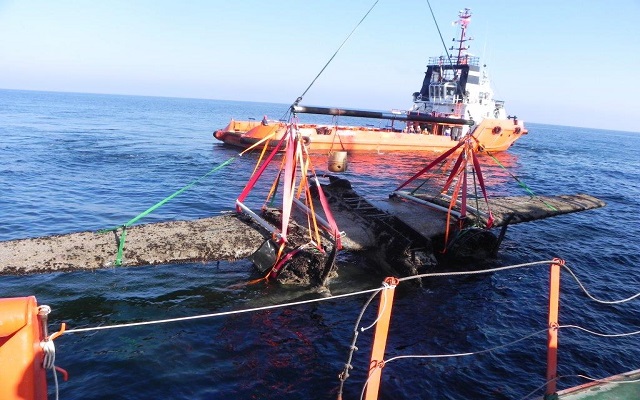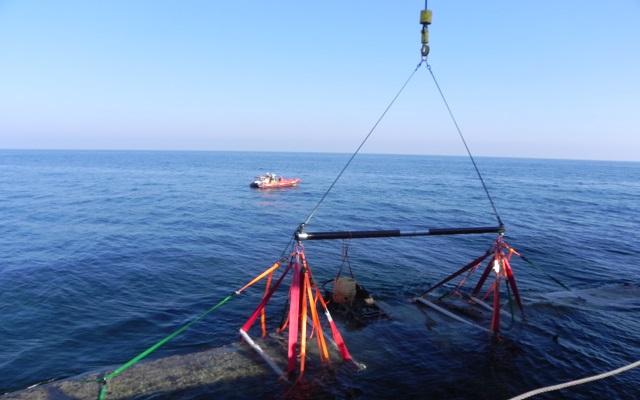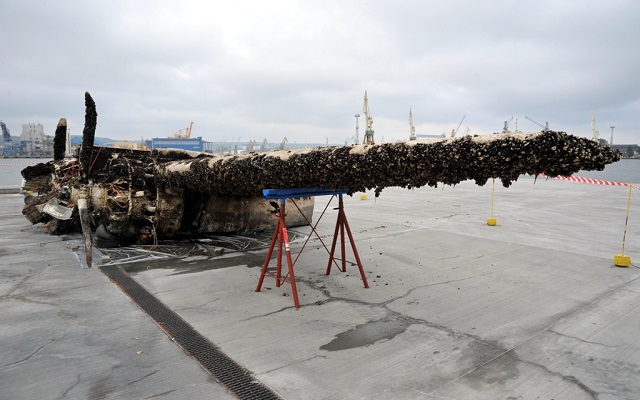News
Update
This website was modified recently: 2015-03-21 11:05.
A wreck of the bomber Douglas A-20 already on the surface
The lifting and extraction action to the surface of an aircraft's wreck from the second World War was a success. US production bomber probably belonging to the Soviets was found some time ago, but carrying out an increase operation presented many difficulties. Fortunately the action was successful and since yesterday the remains of the aircraft are in a port of the Navy.
The first excavations attemp carried out in autumn 2013. by a private company, assisted by the staff of the National Maritime Museum, came to nothing. The reason was too strong wave action, which created a high risk of damage or even break the wreckage of the bomber, while trying to extract.
Secret - the word was coming again wherever there were references to that plane. Starting with the location, the details concerning its state (in the environment over time rumors began to circulate that the wreck was hooked by an anchor of one of the ships of Polish Navy and as a result got serious damage) to the date of extraction.
All the action to raise the wreck was started on Saturday and lasted for dozen hours. To lift the wreck was used a scientific and research unit "St. Barbara ", equipped with the appropriate equipment in the form of a crane. It was managed to get out Douglas to the surface and move it on board of the tugboat "Cambrian" not until Sunday.
The expedition returned to port in Gdynia on Sunday night. Although employees tvn24 station managed to film the returning units with the plane on the board, no one in the National Maritime Museum confirmed information about the extraction of the bomber. Not until a new week has brought the official info confirming the action carried out extraction and transport Douglas to Gdynia.
Lifting the whole plane wreckage Douglas A-20 from the bottom of the Baltic Sea is the first of its kind, a professional attempt of Polish Museum and one of the most spectacular events in the Polish archaeology since the war time.
It is also an important project for the Polish museology, to which draws attention PhD Jerzy Litwin, the director of the National Maritime Museum. Plane after the extraction will be handed over to a specialist museum facility which is the Polish Aviation Museum in Krakow, where it will be subjected to the conservational process and further researches.
"Lifting the whole plane from the bottom of the sea is a very big challenge, requiring specialized knowledge, experience and precise coordination of the projecting team" - says Iwona Pomian, Head of Underwater Research of the National Marine Museum in Gdansk, coordinator of the extraction project. - "The task was hampered by the fact that Rozewie, where was the wreck of the plane Douglas A-20, is particularly vulnerable to wind and waves. Thanks to the fine weather we were witnesses of the only one in Poland lifting of the entirely aircraft from the time of the second World War from the bottom of Baltic Sea" - she adds.
"The wreck was 70 years under water, but is preserved in good condition. In addition to the unique value of the object resulting from the few preserved, worth of saving this type of airframes, we can practically talk about the uniqueness of find and its great importance for Polish museum collections "- emphasizes Iwona Pomian.
Whereas, however, the saga that over the past year has provided us with a lot of emotions is coming to an end. From the moment of finding the bomber by the staff of the Maritime Office in Gdynia, through the interesting history of this American construction, the decision of extraction, restoration and handing over the A-20 to the Polish Aviation Museum, to subsequent attempts to extract, finally ended in success.
This is not the first time when the Navy assists in the protection of monuments lying in the sea. The cooperation started in the last century during studies of wrecks "Copper", "Book", "Grain" and "Solen". Recently the museum and Navy divers worked by extraction of iron guns of the eighteenth century found by the Maritime Institute in Gdansk 30 nautical miles from the port in Ustka. LOTOS Petrobaltic, in turn, became famous for the discovery at the bottom of Baltic Sea of a wreck of the German aircraft carrier "Graf Zeppelin".
As reported by the National Maritime Museum in a press release, the object is the sixteenth preserved monument of this kind in the world, and it is extremely valuable exhibit for the Polish museology .
More details will be given after the conference of the National Maritime Museum. By the extraction museum was supported by partners like the Polish Navy and LOTOS Petrobaltic, which lent their units "St. Barbara" and "Cambrian".
Source: www.divers24.pl










